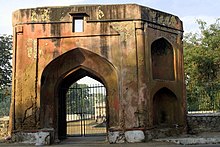Roshanara Bagh
| Roshanara Gardens | |
|---|---|
 A view of Roshanara Garden | |
 | |
| Type | Mughal garden |
| Location | Delhi, India |
| Coordinates | 28°40′23″N 77°11′52″E / 28.67306°N 77.19778°ECoordinates: 28°40′23″N 77°11′52″E / 28.67306°N 77.19778°E |
| Area | 57.29 acres (23.18 ha) |
| Opened | 1650s |
| Founder | Roshanara Begum |
| Owned by | North Delhi Municipal Corporation |
| Operated by | North Delhi Municipal Corporation |


Roshanara Garden is a Mughal-era garden built by Roshanara Begum, the second daughter of the Mughal emperor Shah Jahan. It is situated in Shakti Nagar near Kamla Nagar Clock Tower and North Campus of University of Delhi. It is one of the biggest gardens in Delhi having a great variety of plants, some imported from Japan.[citation needed] The lake inside the gardens is visited by migratory birds during winters and is a popular site for bird watching.[citation needed]
The garden has a raised canal with flowering plants on both sides. Today the garden holds a white marble pavilion built in memory of the princess Roshanara, who died in 1671 and was buried there. The elite Roshanara Club, which was started here in 1922 by the British, is spread over 22 acres.[1] Since 1927 first class cricket is played at the Roshanara Club Ground,[2] which now boasts floodlights. The club is considered the birthplace of the Board of Control for Cricket in India (BCCI). Post Independence cricket administrators gathered in front of an old fireplace and sowed the seeds of the Indian cricket body.[1]

History[]
The garden and the tomb within were constructed by Roshanara Begum beginning in 1650. Her tomb is the only structure that remains of the garden's original appearance.[3]
Transport[]
It is serviced by the Pul Bangash metro station on the Red Line of Delhi Metro. It is situated close to National Highway 1 on the Grand Trunk Road.
See also[]
- Lal Bangla in Delhi, mausoleum of Lal Kunwar, the mother of Shah Alam II (1759-1806), and his daughter Begum Jaan
References[]
- ^ Jump up to: a b "Welcome to Roshanara Club Ltd Estd. 1922". Roshanara Club. Archived from the original on 1 March 2015. Retrieved 9 December 2014.
- ^ "First-Class Matches played on Roshanara Club Ground, Delhi". CricketArchive. Retrieved 9 December 2014.
- ^ Asher, Catherine B. (24 September 1992). Architecture of Mughal India. Cambridge University Press. p. 203. ISBN 978-0-521-26728-1.
External links[]
![]() Media related to Roshanara Bagh at Wikimedia Commons
Media related to Roshanara Bagh at Wikimedia Commons
- The Herbert Offen Research Collection of the Phillips Library at the Peabody Essex Museum Archived 30 January 2010 at the Wayback Machine
- Mughal gardens in India
- Tourist attractions in Delhi
- North Delhi district
- Garden stubs
- Indian building and structure stubs
- Indian history stubs
